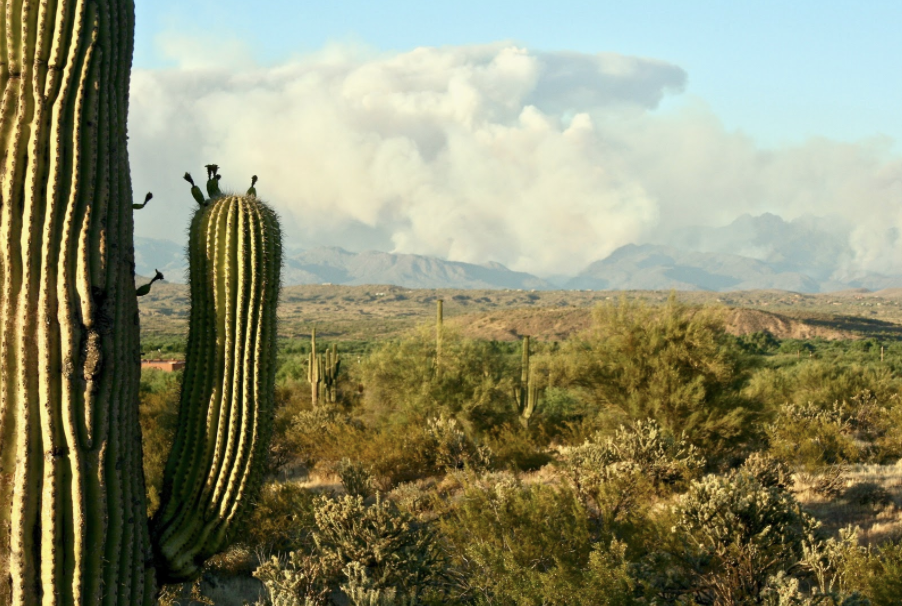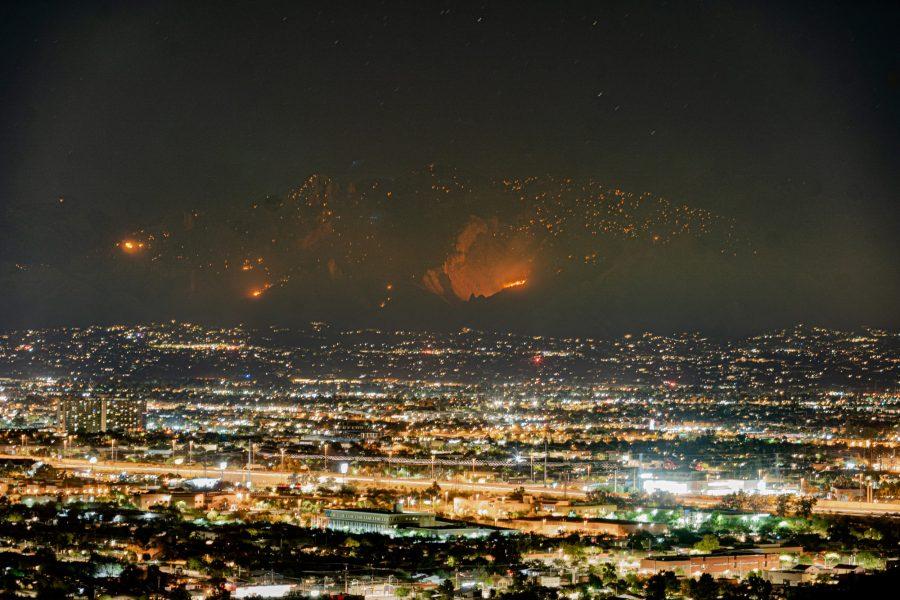From the Bighorn Fire continuing to burn through the beloved Catalina Mountains to the human-caused Bush Fire near Phoenix, now deemed as the largest current fire in the U.S., fires are taking a toll on the wilderness of Southern and Central Arizona.
Some of the major fires burning in Arizona at the moment include the Bighorn Fire outside in the Catalinas, the Bush Fire near the Four Peaks Wilderness, the Sawtooth Fire near the Superstition Mountains and the Blue River Fire near San Carlos.
According to the Arizona Emergency Information Network, Bighorn Fire has now reached 37,058 acres and is 40% contained and the Bush Fire has reached 151,075 acres at 5% containment, as of June 19. According to the Fire, Weather & Avalanche Center, the Sawtooth fire is at 24,729 acres with an 85% containment while the Blue River Fire has reached more than 30,000 acres and is only 10% contained.
An AZEIN press release noted that on June 16, 170,000 acres in Arizona had been engulfed in wildfires during this year alone, and this figure has grown significantly since. As of the June 16, 123,000 more acres had been burned in comparison to last year during the same time period. Most of this has been in southern Arizona because of the difference in vegetation, moisture and temperature from northern Arizona.
“It takes a little longer for fire activity to hit northern Arizona just because of the cooler temperatures at this time of the year, they have more moisture, the fuel content in the pines holds longer,” explained Tiffany Davila, a public affairs officer for the Arizona Department of Forestry and Fire Management. “While there are some fires actively burning in northern Arizona, we’re seeing more of an increase in southern and central Arizona.”
Despite the many benefits that wildfires can have on some ecosystems such as supporting soil fertility and eliminating invasive vegetation, southern Arizona does not always have the same luck. In northern Arizona, ecosystems may derive more benefits from wildfires than ecosystems in southern Arizona.
RELATED: The Bighorn Fire progresses as people begin to evacuate their homes
Ann Youberg, a senior research scientist at the University of Arizona specializing in hazards such as landslides and post-wildfire debris-flows, compared the different benefits between wildfire-reliant ecosystems and southern Arizona ecosystems.
“You get into the grasslands, the pinyon-juniper, the pines, the spruces — those are all fire-adapted communities and they need fire to behave properly,” Youberg explained. “The Sonoran Desert is not a fire-prone ecosystem; it doesn’t do well with fire.”
According to Davila, most of the wildfires in southern Arizona this year have been human-caused; while a lot of acreage has been burned from lightning-caused fires like the Bighorn Fire and the Blue River Fire, 95% of fires have been from human causes such as illegal target shooting, escaped burn barrels and abandoned campfires.
“While we do get lightning strike fires, and we will see an increase in those once we get into monsoon season, when we get more of the dry lightning. Every year, people are the number one cause of our fires in Arizona,” Davila explained.
Regardless of the cause of the fires, the major issue highlighted by Davila and other wildfire-concerned professionals in southern Arizona is the ability for them to ignite and spread so rapidly. So, why are these southern and central Arizona wildfires igniting so frequently and spreading so rapidly?
According to Molly Hunter, a public information officer for the Southwest Area Type 1 Incident Management Team 2, wildfire spread has been attributed to three factors: topography, weather and fuels.
“Topography is important because steep slopes and narrow canyons are things that can exasperate fire spread,” Hunter said. “It spreads faster and hotter in those kinds of areas.”

Topography has especially been a challenge in regards to the Bighorn Fire and the Bush Fire, as they continue to burn among mountain ranges with rugged and volatile terrain. This not only influences the spread of the fire, but it makes it difficult for fire personnel to go in and fight it. Hunter also described that weather and climate trends in southern Arizona support wildfire ignition and growth.
“Wind is a critical factor, dryness is a critical factor, heat is a critical factor and those are all things that are just very common … they align frequently in Arizona, particularly in southern Arizona,” Hunter said.
During this time of year, known to many as Arizona’s wildfire season, heat, dryness and winds dominate weather patterns. In addition to short-term weather circumstances playing a role in rapid wildfire ignition and growth, research has shown that climate change could play a role in increased wildfire activity. For example, a 2017 UA study predicted that land burned by wildfires would increase alongside the changing climate.
According to Hunter, climate change may also be playing a role in prolonging wildfire season.
“As temperatures have increased, one of the biggest impacts it’s had on firefighting operation is that the fire season is much longer now,” Hunter said. “With a longer fire season, that just means there’s more opportunities for fires to start and more time for them to grow.”
Vegetation and fuels is a factor that puts southern Arizona especially at risk for wildfires during dry, windy seasons. According to Davila, one of the most significant reasons for these wildfires is the conditions surrounding Arizona’s fuel bed, which is the concentration of surface-level fine fuels such as dry grass and brush.
“We have an overgrowth of the fine fuel beds, so those are like the grass vegetation, the typical vegetation you would see within the desert,” Davila explained.
RELATED: Minority groups hit disproportionately harder, pandemic exposes racial disparities in healthcare
After winter moisture fostered the overgrowth of these fine fuels, hot temperatures in April quickly dried out the fuels, resulting in an abundance of tall, dry grass and brush.
“You already have this overgrowth of vegetation, the winter rains come in and add to the problem, and then it just increases,” Davila said. “Then we have this overgrowth of dry fuel bed, and its a continuous fuel bed — that’s why the fires are moving so quickly.”
Youberg indicated that some of the major fuels come in the form of invasive species of vegetation, which have overpopulated the Sonoran Desert. For example, buffelgrass, which was introduced to the Sonoran Desert in the early 1900s to control erosion, burns easily and sprouts again quickly after fires. According to Tucson Clean & Beautiful, Inc., buffelgrass burns very hotly — above 1,600 degrees which can melt many metals.
The rapid ignition and growth of so many fires and the increase in acreage burned is a concern for a number of reasons. Davila emphasized the importance of taking preventative measures and continuing to stay updated on wildfire conditions in Arizona.
“Wildfires are impacting not only the land, they’re impacting people,” Davila said . “People are having to be evacuated, we lost structures on the Ocotillo Fire, that’s someone’s livelihood, our wildlife, watershed — there’re a lot of reasons why people need to be concerned and take those preventative measures.”
An additional reason for concern is the potential for increased post-fire flooding.
As fires continuously burn down vegetation and change the soil, the earth loses its capacity to absorb rain and water flow. When the surface is cleared and there is less of infiltration capacity, the speed of water flow increases, especially in mountainous and hilly areas. This can result in more intense flash floods. Youberg explained that, come monsoon season, this can be a very serious issue.
“People need to be careful in an average monsoon storm, and an average monsoon storm after fire is way worse because the amount of flooding that can come off of these burned areas is really significant,” Youberg said.
Youberg also pointed out that as fire weathers the soil, it makes it more easily erodible. This can result in heavy debris-flows, capable of putting people, homes and ecosystems in danger.
Aside from all of the specific dangers of wildfires in southern Arizona, Hunter takes a broad, holistic stance, drawing attention to the intrinsic and economic value of the Sonoran Desert.
“They are detrimental to the ecosystems and of course; the Sonoran Desert is a real treasure for us locally and is important for us economically as well,” Hunter said.
To protect from further wildfire damage, Arizonans can continue to adhere to regulations regarding wildfire prevention, create defensible space around property, stay updated on current fires and spread awareness on climate change and other long-term stimulants for wildfires.
Follow Quinn McVeigh on Twitter









